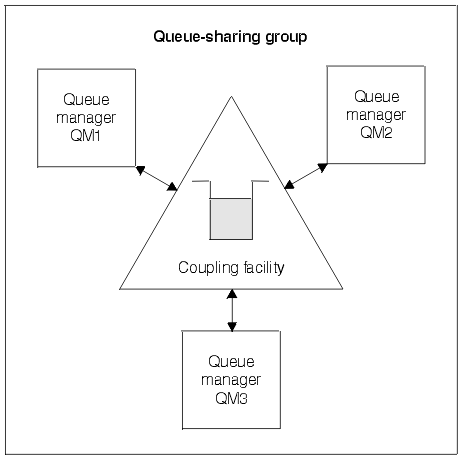What is a shared queue?
A shared queue is a type of local queue. The messages on that queue can be accessed by one or more queue managers that are in a sysplex.
A queue sharing group
The queue managers that can access the same set of shared queues form a group called a queue sharing group.
Any queue manager can access messages
Any queue manager in the queue sharing group can access a shared queue. This means that we can put a message on to a shared queue on one queue manager, and get the same message from the queue from a different queue manager. This provides a rapid mechanism for communication within a queue sharing group that does not require channels to be active between queue managers.
IBM WebSphere MQ Version 7.1 and later supports the offloading of messages to Db2 or a shared message data set (SMDS). The offloading of messages of any size is configurable.
In earlier versions of IBM MQ, large messages (> 63 KB) have a placeholder stored in the coupling facility (4 K), and their message data stored in Db2.
Figure 1 shows three queue managers and a coupling facility, forming a queue sharing group. All three queue managers can access the shared queue in the coupling facility.
An application can connect to any of the queue managers within the queue sharing group. Because all the queue managers in the queue sharing group can access all the shared queues, the application does not depend on the availability of a specific queue manager; any queue manager in the queue sharing group can service the queue.
This gives greater availability because all the other queue managers in the queue sharing group can continue processing the queue if one of the queue managers has a problem.

Queue definition is shared by all queue managers
Shared queue definitions are stored in the Db2 database table OBJ_B_QUEUE. Because of this, we need to define the queue only once and then it can be accessed by all the queue managers in the queue sharing group. This means that there are fewer definitions to make.
By contrast, the definition of a non-shared queue is stored on page set zero of the queue manager that owns the queue (as described in Page sets ).
We cannot define a shared queue if a queue with that name has already been defined on the page sets of the defining queue manager. Likewise, we cannot define a local version of a queue on the queue manager page sets if a shared queue with the same name exists.
Parent topic: Shared queues and queue sharing groups